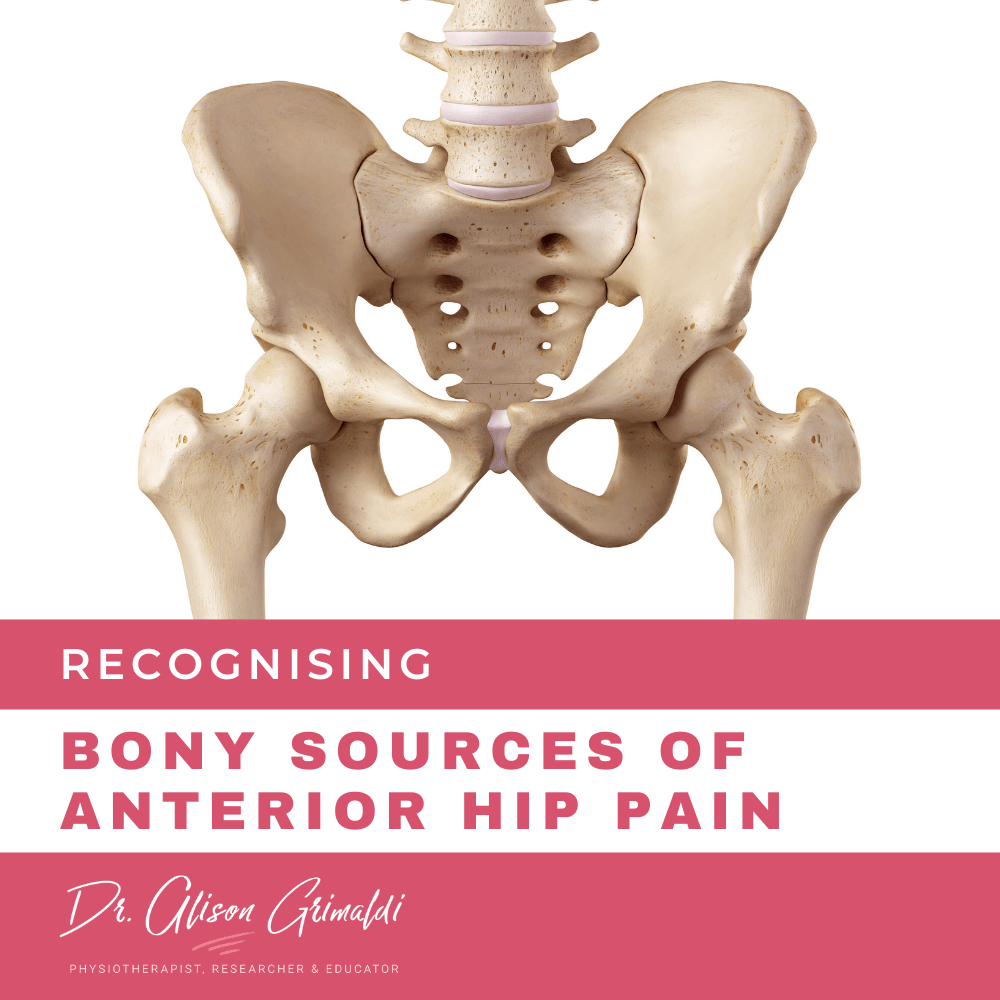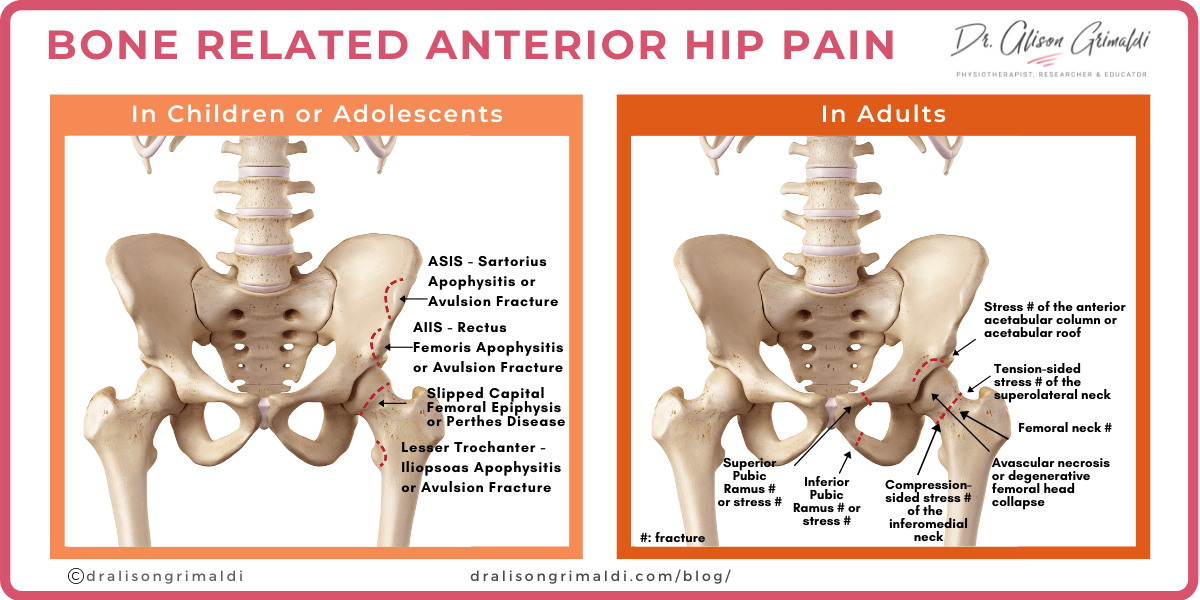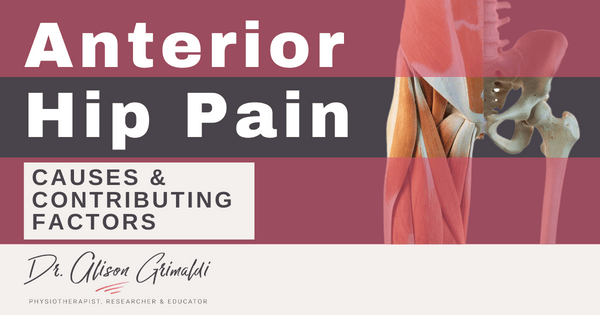Differential Diagnosis of Anterior Hip Pain – Bone

We started our journey into differential diagnosis of anterior hip pain in last month's blog on joint related anterior hip pain. This month, our differential diagnosis moves to bone related anterior hip pain. It might be surprising how many different bony conditions need to be considered when examining a patient with anterior hip pain. While load related pain is common to many conditions, patient demographics and the history of the onset of pain can provide important clues that might point to a bone related anterior hip pain.
Can't make the workshop? Do the Online Course

Bony Sources of Anterior Hip Pain
While cartilage is aneural, bone is well innervated and can be a source of anterior hip pain for a variety of reasons. The acetabulum, head and neck of the femur and in children and adolescents the bony growth plates may all become sources of nociception. The pubic rami are also sites of stress fracture or traumatic fracture, although the pain is usually a little more medial, towards the groin.
Bone related conditions associated with anterior hip pain
In adults, bony structures of the anterior hip are subject to traumatic or fatigue fractures, most commonly stress fractures in endurance athletes or military recruits. Avascular necrosis of the femoral head and collapse of the femoral head related to end stage degenerative change+/- steroid injection may occur. In children and adolescents, where the growth plates are open, bone pain may arise from apophysitis or avulsion or disturbance of the femoral head epiphysis.
- In adults,
- fractures or stress fractures of the:
- acetabular roof or anterior column1
- femoral neck - compression-sided fractures of the inferomedial neck (more stable); tension-sided fractures of the superolateral neck (emergency situation)2,3
- inferior or superior pubic rami2
- avascular necrosis (osteonecrosis) of the femoral head4
- femoral head collapse in end stage OA +/- steroid induced response5
- fractures or stress fractures of the:
- In children or adolescents,6,7
- apophysitis or apophyseal avulsion of:
- the Anterior Superior Iliac Spine - Sartorius
- the Anterior Inferior Iliac Spine - Rectus Femoris
- the lesser trochanter - Iliopsoas
- disturbance of the femoral head epiphysis
- slipped capital femoral epiphysis
- Perthes disease/ Legg-Calve-Perthes Disease
- apophysitis or apophyseal avulsion of:

Features of bone related anterior hip pain
- Fractures:
- Patient presents with severe hip pain and usually an inability to weightbear
- Most commonly associated with trauma or a final precipitating event, for example if a stress fracture converts to a full fracture
- More likely to present to a hospital emergency department than a community health centre.
- Stress fractures:1,2,3
- Patients with stress fractures of the femoral neck or acetabulum usually present with pain in the anterior hip, groin +/- proximal thigh. Those with pubic rami stress fractures usually present with more medial groin pain.
- Pain is related to activity, particularly weightbearing impact loading. Initially the pain may develop towards the end of a run but the pain then increases to severe pain that the athlete experiences even in walking
- May have an antalgic gait, particularly when weightbearing pain is severe
- May have pain at end-of-range motion, particularly internal rotation
- Consider stress fractures particularly in running endurance athletes, or military recruits
- Risk factors include rapid increase in activity (usually running/impact loading), decreased femoral bone mineral density, gluteus medius weakness, femoroacetabular impingement and coxa vara (a more horizontally oriented femoral neck)2,3
- Avascular necrosis (osteonecrosis) of the femoral head:4
- Patients usually report progressively worsening anterior hip pain, that may radiate to the groin or buttock
- Pain is aggravated by weightbearing activity, but as the condition progresses pain may also be present at rest
- Initially there are a lack of physical signs, with range of motion limitations and limping usually only presenting in later stages where femoral head collapse has often begun
- Development of avascular necrosis may be idiopathic but a number of risk factors have been identified:
- Traumatic risk factors: hip dislocation, femoral neck fracture, intramedullary nail
- Atraumatic risk factors: chronic health conditions such as systemic lupus erythematosus, sickle cell disease, liver failure, coagulopathy; lifestyle factors such as alcohol abuse; pharmacological factors such as long-term use of corticosteroids.
- Femoral head collapse associated with advanced osteoarthritis is not that common, as most patients will have presented with symptoms of significant hip osteoarthritis and had imaging, surgical consult and progression to arthroplasty before collapse. However, intra-articular cortisone injection may induce rapid joint destruction in some people5, so if a patient with advanced joint change undergoes rapid deterioration of symptoms after an injection, joint collapse should be suspected.
- Apophysitis:
- Apophysitis is related to overload at the apophysis, usually due to high volume and/or intensity of activity and/or related to a rapid growth spurt with relative tightness of the biarticular musculature secondary to rapid long bone growth of the femur
- Pain is typically activity related and eases with rest
- Anterior Superior Iliac Spine (ASIS) Apophysis - Pain and tenderness locally
- Anterior Inferior Iliac Spine (AIIS) Apophysis- Pain at anterolateral hip in AIIS region
- Less trochanter - Iliopsoas - pain is usually lower and more medial
- Apophyseal pain is usually reproduced on resisted contraction or stretch of the attaching muscle
- ASIS - Sartorius - Action: hip flexion/abduction/external rotation
- AIIS - Rectus Femoris - Action: hip flexion/knee extension
- Lesser trochanter - Iliopsoas - Action: hip flexion
- Apophyseal avulsion:6,7
- Rapid onset related to a large muscle pull from the hip flexors on their respective apophyses, usually eccentric loading
- Common mechanisms are kicking or rapid acceleration or deceleration when running
- Patients will often report feeling and/or hearing a “pop” at the time of the injury
- Pain and weakness on hip flexion, straight leg raise + on knee extension (AIIS avulsion) or knee flexion (ASIS avulsion)
- Typical age range for avulsions: 11 - 16 years for girls and 12-18 in boys
- AIIS avulsions are more common in males and ball sports
- Perthes Disease/Legg-Calve-Perthes Disease:6
- Related to osteonecrosis of the proximal femoral epiphysis and resulting in deformity of the femoral head
- Most common in male children, average age 7 years
- Child presents with anterior hip and knee pain, reduced range of motion and an antalgic limp
- Slipped Capital Femoral Epiphysis:6
- Most common in males aged 10-16 years
- Onset may be traumatic, but more common to present with an insidious onset of anterior hip pain, which may refer to the knee
- Pain is usually achy in nature and aggravated by physical activity.
- Walk with foot turned out - hip externally rotated
- Loss of range and usually pain on flexion and internal rotation
- Risk factors include obesity, pubertal growth spurt, inflammatory conditions & endocrine disorders
KEY IDENTIFIERS OF BONE RELATED ANTERIOR HIP PAIN
Bone related anterior hip pain is typically worse on weightbearing activity, with more severe conditions resulting in severe pain and an inability to exercise or even weightbear. Key indicators are usually around patient age and/or history.
- Acute trauma - consider fracture
- Pain in an endurance athlete that has developed with increase in training load, particularly with rapid development of severe pain on weightbearing activity - consider stress fracture
- Insidious onset of anterior hip pain in an adult, that does not have a typical mechanical pattern - consider avascular necrosis, particularly if any risk factors
- Activity related pain in apophyseal regions in an adolescent - suspect apophysitis
- Sudden onset apophyseal pain and weakness related to a forceful eccentric hip flexor action - suspect apophyseal avulsion
- Child less than 10 years with insidious onset anterior hip and knee pain, and limp - consider Perthes disease
- 10-16 year old male with insidious onset anterior hip and knee pain, with antalgic, externally rotated gait - consider Slipped Capital Femoral Epiphysis
Screening for red flags should always be included in the patient interview, with bone tumours and infection (osteomyelitis) within the differential diagnosis of anterior hip pain.
Download your FREE 12-page Book
Easily recognise the potential source of nociception or referral within the differential diagnosis of Anterior Hip Pain, with this Free eBook.
So far we've covered joint and bone related anterior hip pain in the differential diagnosis of anterior hip pain. We have yet to cover soft tissue and nerve related anterior hip pain. This information will be coming out in my next blogs - sign up to my newsletter if you want to make sure you don't miss the remaining information.
Another great Anterior Hip Pain blog

Anterior Hip Pain: Causes & Contributing Factors
Adequate consideration of individual causes and contributing factors is important for best outcomes.
Sign up to our newsletter to receive updates on upcoming courses, news and special offers.
References
- Williams, T., Puckett, M., Denison, G., Shin, A. and Gorman, J., 2002. Acetabular stress fractures in military endurance athletes and recruits: incidence and MRI and scintigraphic findings. Skeletal Radiology, 31(5), pp.277-281.
- Dutton, R., 2021. Stress Fractures of the Hip and Pelvis. Clinics in Sports Medicine, 40(2), pp.363-374.
- Carpintero, P., Leon, F., Zafra, M., Serrano-Trenas, J. and Roman, M., 2003. Stress fractures of the femoral neck and coxa vara. Archives of Orthopaedic and Trauma Surgery, 123(6), pp.273-277.
- Colomb-Lippa, D., 2014. Avascular necrosis of the femoral head. Journal of the American Academy of Physician Assistants, 27(7), pp.40-41.
- Kompel, A., Roemer, F., Murakami, A., Diaz, L., Crema, M. and Guermazi, A., 2019. Intra-articular Corticosteroid Injections in the Hip and Knee: Perhaps Not as Safe as We Thought? Radiology, 293(3), pp.656-663.
- Schroeder, P., Nicholes, M. and Schmitz, M., 2021. Hip Injuries in the Adolescent Athlete. Clinics in Sports Medicine, 40(2), pp.385-398.
- Yeager, K., Silva, S. and Richter, D., 2021. Pelvic Avulsion Injuries in the Adolescent Athlete. Clinics in Sports Medicine, 40(2), pp.375-384.



